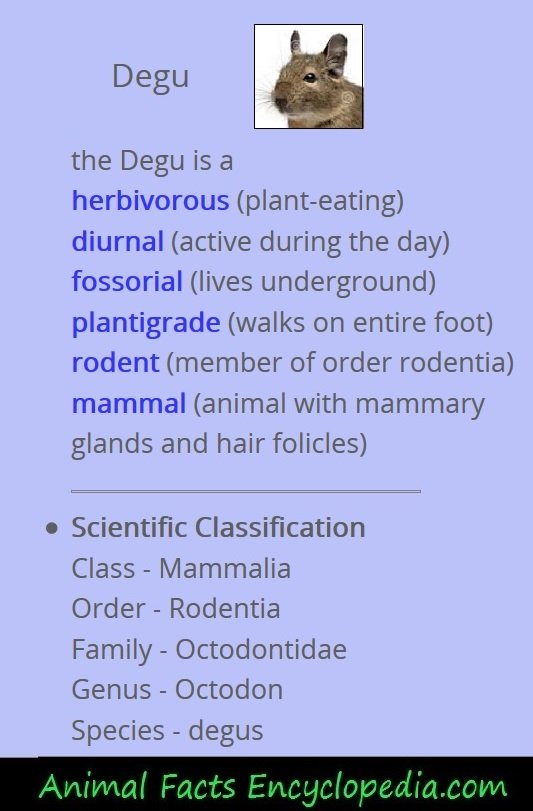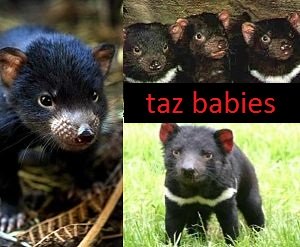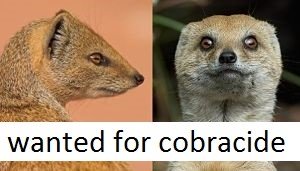Degu Facts
 Portrait of a Degu
Portrait of a DeguOne of the coolest degu facts is that they make great pets!
A close relative of the chinchilla, the degu is a gentle little rodent native to the rocky outcrops of the Chilean lowland.
The common degu looks very much like an oversized gerbil, with brown fur, thin-skinned, rounded ears, and a bit of a Roman nose.
But the gerbil rarely reaches 2 ounces, while the degu averages about 8 ounces.
Degus are extremely social creatures, living in huge communities of as many as 100 individuals.
They cooperate to dig extensive underground living quarters, which have dozens of tunnels leading to an assortment of different compartments.
There are nurseries, bed rooms, and food stores, and all members of the colony work together in groups called digging chains to remove soil to create new chambers and tunnels.
Female degus share in the rearing of offspring, and will even nurse eachothers young.

Degus are diurnal, out and about during daytime hours, and spend a large part of the day foraging.
Their natural environment is harsh and arid, and the degu lives on a unique diet of dry leaves, grasses and occasional seeds.
Because of the unique terrain, their diet is very specific.
There are no fruiting plants or vegetables available to feed on, which is the staple of most small rodents, and the digestive tract of the common degu has evolved accordingly.
Since the simple sugars from fruits are not in their natural diet they have a poor tolerance for it, and have been used extensively in diabetes research because of this.
Degus are simple to care for and easy to handle so they were ideal subjects for research not just on diabetes, but also for Alzheimer's.
Degus develop the hallmarks of the disease as they age, sometimes as soon as the age of three.
Overtime, the researchers that worked with degus in laboratories, realized the little rodents impressive intelligence.
how smart are degus?
High intelligence is often found in animals that live in large, cooperative communities.
They develop trust, problem-solving skills, and even empathy.
Degus have displayed a few specific behaviors that suggest a degree of reasoning, including simple tool use, and even an understanding of object size.
For instance, degus have been observed stacking items in size order, and researchers in Asia have filmed them learning to use a little rake to retrieve treats from under a barrier.
So how smart are degus?
Well, only some limited studies have been done, but most researchers think they may be equal to raccoons in intelligence, learning to escape and problem solve with great mental dexterity.


degus as pets
Degus can make excellent pets if you are willing to provide them with the mental stimulation they need, and the social stimulation they require.
Most experts suggest having at least two, because they are such social creatures.
Having a small colony of four to eight would be ideal, however, and allows you to observe the amazing relationships and communication between them.
Degus require large cages with exercise wheels, because, in general, they are the more active than any of the other small rodents or lagamorphs folks keep as pets.
They are diurnal, which means they are awake during the day which is very appealing for folks who have had nocturnal pets like hamsters, that sleep during the day and spend the entire night gnawing and running on their wheels.
Degus also have a fairly long lifespan, often living 10 years or more. Chinchillas may live well into their teens, but most of the other rodents live 6 years or less, with pet hamsters often not making past 2 years.
Degus can be adorable and affectionate pets, enjoying being stroked and scratched, and greeting their humans with happy squeal and chatters.


a few more Degu facts

- Degus are related to chinchillas
- but degus are not nocturnal, they are awake during the day
- Degus live in huge colonies of as many as 100
- The degu is not tolerant of sugars, and is used in diabetes research
- Degus are usually brown, but some pets come in new colors
- Degus are very vocal, making chattering, squeaking and chuckling noises
see more animal extreme closeups
Recent Articles
-
African Animals - Animal Facts Encyclopedia
Oct 11, 16 10:27 PM
African Animals facts photos and videos..Africa is a wonderland for animal lovers, and a schoolroom for anyone who wants to learn about nature, beauty and the rhythm of life -
Baboon Facts - Animal Facts Encyclopedia
Oct 11, 16 10:26 PM
Baboon facts, photos, videos and information - Baboons are very distinctive looking monkeys with long, dog-like snouts and close set eyes. -
Great Apes Facts - Animal Facts Encyclopedia
Oct 11, 16 10:25 PM
Great apes facts, photos and videos..Human beings did not evolve from chimpanzees, modern chimps and gorillas do not appear in the fossil records until much more recently than homo sapiens..























